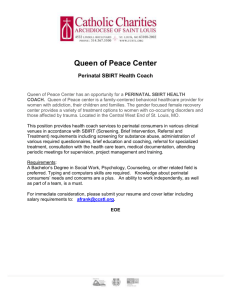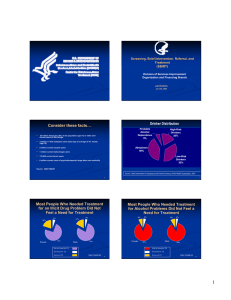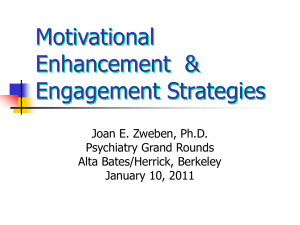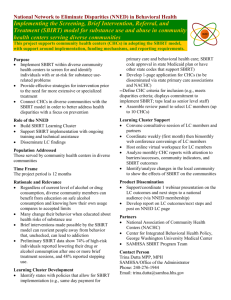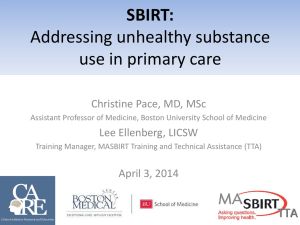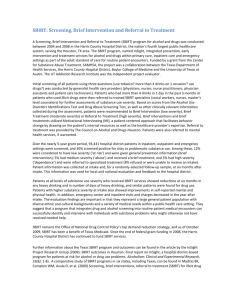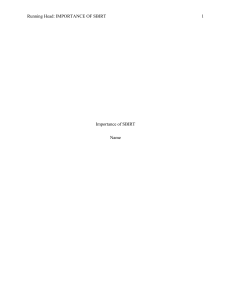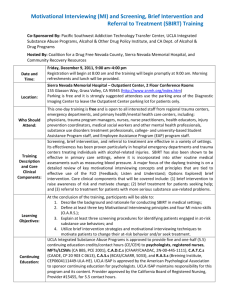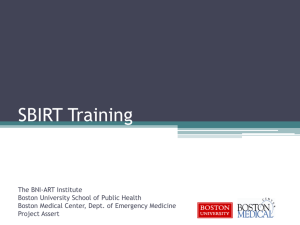Satterfield Oral 2015
advertisement
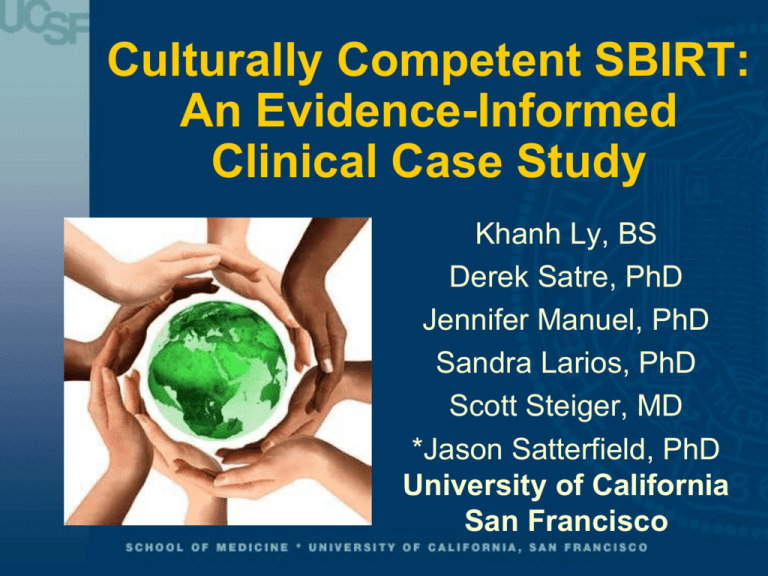
Culturally Competent SBIRT: An Evidence-Informed Clinical Case Study Khanh Ly, BS Derek Satre, PhD Jennifer Manuel, PhD Sandra Larios, PhD Scott Steiger, MD *Jason Satterfield, PhD University of California San Francisco Roadmap n n n n SBIRT overview: Summary of recommendations Literature review: Cultural Competence Notions of “competence” Clinical case presentation u Illustrations of adaptations Funding: SAMHSA/CSAT grant #1U79TI025404-01 awarded to Dr. Satterfield No Conflicts of Interest to Report Learning Objectives n n n To understand how cultural considerations can impact SBIRT delivery in primary care. To illustrate specific SBIRT adaptations to better serve diverse patients. To explore cultural factors such as family and community values that may influence motivation to reduce substance use. SBIRT Recommendations n n n USPSTF recommends annual, universal screening for alcohol in adult primary care (Whitlock et al., 2004) Positive screen followed by more in depth assessment for severity and possible diagnosis Brief intervention and/or referral to treatment with scheduled F/U SBIRT and Diverse Patients? n Screening: n=13 studies u u u u Language, literacy Stigma, privacy, power AUDIT has broad support, available in the most languages F Sensitivity remains high but specificity is lowered especially some Chinese translations ASSIST – internationally developed (WHO) SBIRT and Diverse Patients? n BI: n=8 studies (usually 1-2 brief discussions) u Motiv Interviewing (or MI “spirit”) most commonly used. F Meta-analysis: Hettema et al., 2005 u BNI – ED settings (e.g. Bernstein; D’Onofrio) F + results for cocaine, opioids, alcohol u +/- for PC illicit drugs (Saitz, Roy-Bryne, Gelberg) Culture, Social and Structural Contexts n n n n Culture Characteristics u Language, beliefs, customs, food, music, communication style, health practices Education u Literacy, health literacy Geography, neighborhoods Resources, “structures” that influence the experience of health, illness, and health interventions Notions of “Competence” n n n Early approaches to cultural competence u The checklist approach Middle approaches u General skills Current approaches u Structural competence (Hansen) u Critical consciousness (Lypson) Clinical Case: Ronaldo (Satre et al., 2015) n n n n 47yo married man seeing PCP HPI: Back pain after alcohol-related fall Soc Hx: Born in Honduras, bilingual, HS education + trade school, 2 adult daughters, social pressure to drink Screening and Assessment u AUDIT = 17 (at risk/hazardous) u Motiv Interviewing, DSM Dx = SUD, mild? SUD and Tx Epidemiology n n n Some studies suggest substance use disorders are over-represented in Latino men (SAMHSA, 2013) SUD treatment is underutilized(by everyone) but especially by racial and ethnic minorities (Cook & Alegria, 2011) Hispanic men have more problems related to alcohol compared to whites (Caetano, 2003) Notions to keep in mind n n n First – language and literacy Second – power, trust, respect Third – culturally tied considerations u familismo u espiritismo u machismo u respeto Clinical Case Conclusion n n n n What did Ronaldo’s PCP do? She assessed acculturation and patient preferences re interview language and style. She used familismo, respeto, and machismo to facilitate discussion of material and build motivation Negotiated a reduction in drinking and approach to managing pain Culturally “Competent” SBIRT? n n n Cultural and structural sensitivity seem achievable for screening and BI There are few studies on exactly how to adapt/improve interventions Better attention to cultural and structural factors may be a missing “active ingredient” for BI’s Thank You Jason.Satterfield@ucsf.edu n UCSF Collaborative Education Project u u u u u u Kathy Julian Sandra Larios Khanh Ly Jennifer Manuel Ellie McCance-Katz Gina Moreno-John u u u u u u Pat O’Sullivan Derek Satre Scott Steiger Janice Tsoh Maria Wamsley Patrick Yuan
